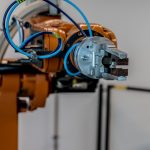Magnets and Automation in the Face of Social Distancing
The world is currently facing a pandemic and people are being encouraged to practice social distancing for the foreseeable future. The amount of recommended time for this kind of practice is unknown –– some hypothesizing weeks and others predicting months.
The truth is, even after COVID-19 is under control, it will have a lasting impact on our businesses, but I’m not just talking about the travel industry, the service industry, and small business owners. This will also largely impact the technology sector. Now more than ever, businesses will consider investing in automation to reduce face-to-face contact.
Process automation is the use of technology, and in the case of this blog, magnets, to execute recurring tasks to reduce manual effort and personal contact. Not only would this limit interaction and the potential spread of a virus like COVID-19, it would also minimize costs and streamline overall processes.
But automation has been pondered long before the spread of Coronavirus. Two forms it has taken are self-driving cars and robotic end-of-arm toolings, both of which use magnets to operate.
Self-Driving Cars
You’ve probably heard of the research that both Uber and Lyft are putting into driverless cars. You may have even seen one of their test vehicles (with someone in the driver’s seat, of course) navigating your city. Well, the idea for fully automated cars has been around long before this most recent push.
Volvo once fought for the use of automated magnetic highway systems, researching ways to line highways with neodymium and ferrite magnets, and using automated vehicles with magnets specialized sensors. Later, to improve potential operation along these hypothetical highways, DOE/Ames Laboratory developed a new magnetic alloy made of neodymium, yttrium, and dysprosium, which was able to operate at capacity in up to nearly 400°F temperatures.
While the reality of driverless cars and magnetic highway systems is still theoretical, it might be closer to fruition than we think, especially now, when we’re trying to slow the spread of COVID-19.
Robotic End-of-arm Tools
Magnetic robot end-of-arm tools are suitable for a number of things –– pick-up, placement, and positioning of iron, steel, sheet metal, and other ferromagnetic objects. Their ability to be turned “on” and “off” make them a good alternative to more traditional robot grippers.
While a lot of people picture robotic arms being used in the medical field, performing precision-based surgeries, they’re actually quite useful in a variety of other industries. They could be used in assembly lines, as welding robots, or in warehouses to move sheet metal or other ferrous items. Currently, they’re most often used in automotive industries to move large steel parts, including hydraulic cylinders.
Apex Magnets in These Changing Times
At the end of the day, there are pros and cons to the idea of automation in any industry. On one hand, it’s safer and more cost efficient, and on the other, it makes certain jobs obsolete. It might be the answer to slowing the spread of contagions, but then again, it’s surely only one potential solution of many. Where do you stand? Are you for automation, against it, or somewhere in between?
Please keep in mind that, as an “essential” business, Apex Magnets remains open and continues to operate and ship as normal. Fortunately, our warehouse is large enough that we can practice social distancing effectively, and our team members have been given the option to work from home. If you have any questions or concerns, feel free to give us a call.

